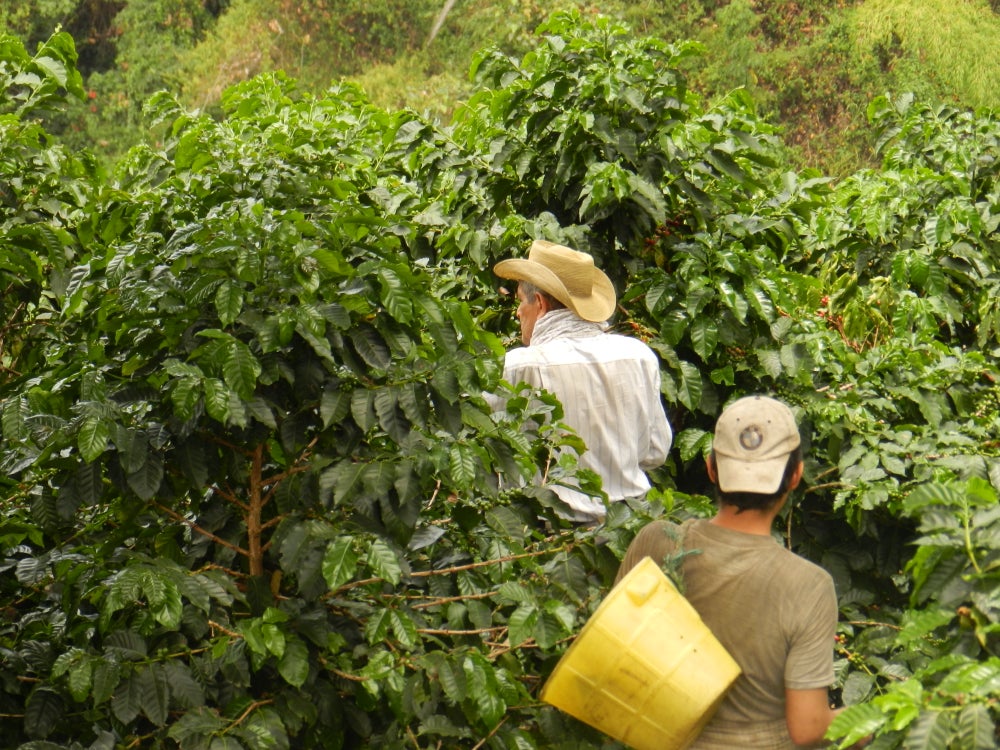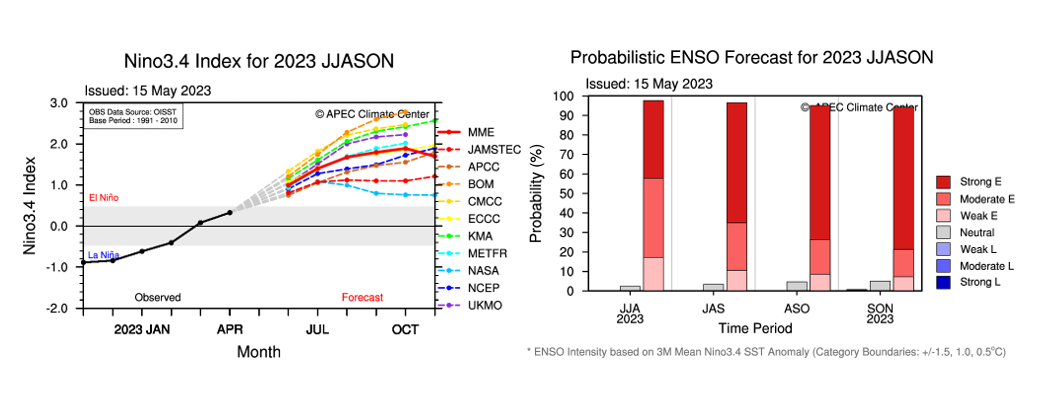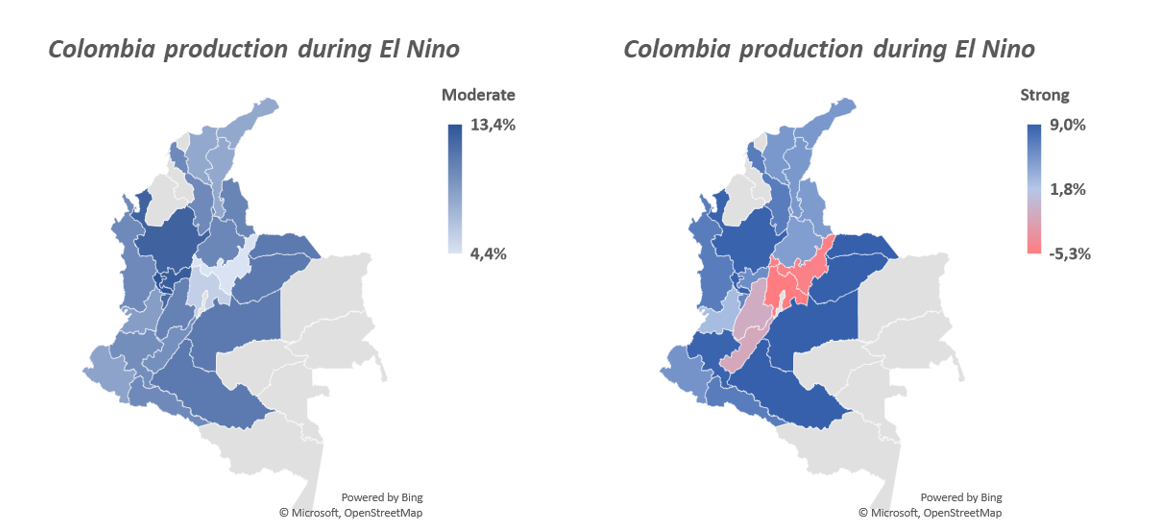From the Field, News, Resources for Roasters
Monday, June 12, 2023
Impacts of El Niño in Colombia
The El Niño phenomenon is affecting the size of upcoming mitaca and main crops in Colombia. El Niño can impact the quantity of rain and sunshine in coffee growing areas and, thus, can affect the size of the harvest. Oscar Fernando Ramirez, Research Manager Americas, and Luis Guillermo Jaramillo, Research Manager Colombia, put together a comprehensive report to share their findings.

Main Conclusions
Weather behavior
The normal period of El Nino influence is around a year on average, but there have been events up to four years (1991 to 1995). There is no consensus among all forecasters about what will be the real magnitude of the current El Nino phenomenon. Dynamic models show a strong event for Aug-Sep-Oct, but Statistical models show a weak event, so we are considering a moderate event in our analysis.
The most critical period that will affect the quality in a more significant way is during the first quarter of the second year, in this case during Jan-Mar of 2024, due to the conflation between lower precipitations & higher max temperatures in a lot of coffee regions.
Production
During a typical El Nino event, the largest increase in production would be during the Mitaca crop. Depending on the El Nino behavior during Q1-2024 (the riskiest period), coffee production for the main 24/25 crop can be positively or negatively impacted. This needs to be monitored.
The most beneficial magnitude in an El Nino event is a moderate type that might increase coffee production by around 15% to 16% while the stronger events (Strong or Very Strong) limit the positive impact at lower levels and can even negatively affect production. In a normal scenario, this could be around 1.3 to 1.8 mm bags of additional production.
Quality Impacts
The most typical impact on quality during an El Nino phenomenon is a coffee borer explosion in all regions above 5% and an increase in the low grades proportion in the total volume above 6% even to 9%.
The low-grade production trend tends to increase during El Nino events thanks to the negative impacts on the beans mainly driven by more coffee borer attacks, more proportion of smaller screen in the total mass as well as more defects in the beans like black bean, filling troubles or “averanado” beans. The low-grade coffees could increase between 2% to 4% more depending on the event’s magnitude, to the next 23/24 crop we are projecting around 732k bags.
Current Global El Nino conditions
During the 2023 year, the global weather conditions have moved from the La Nina event that had a duration of around 36 months and that strongly impacted Colombia’s coffee production for the last 2 years. Now, the weather has had a quick transition towards an El Nino scenario in just two months. Despite this, the current condition is neutral, the forecast is now showing positive anomalies in the El Nino region 3.4 located in the Pacific central ocean.

The probabilistic ENSO forecast points to a weak El Nino during June, July and August then the probability increases faster towards Moderate and even Strong event to the second half of the year.
El Nino impacts by latitude
El Nino has less influence over the north region above 7° north latitude and lower of 3° north latitude. Regions with beneficial effects would be those with higher rainfalls (>2000 mm/year) and lower solar radiation (< 1600 hrs/yearly), some cities located towards southwest of Antioquia, east of Caldas as well as south of Huila among others.
Main typical impacts in climatological indexes during an El Nino event:
- Precipitation: Reduction -22% avg (range -13% to -29%)
- Sunshine: Increase +5% avg (range +3% to +8%)
- Max Temp: Increase +1.1°C avg (range +0.4°C to +1.5°C)
Type of impacts
Flowerings: More concentrated events and with higher magnitude can be observed during a regular El Nino event but if the dry conditions surpass 30 days the flowering could be negatively impacted due to lack of rains for a correct fixation. This could negatively impact production.
Quality: On-field the conversions from coffee cherry to dry parchment can at worse surpass the relation 5:1 due to higher losses (merma) & low-grades increases. The coffee borer (broca) might increase above 5% or even up to 15% locally.
Vegetative effects: Plants might be impacted by lower vegetative growth reducing the next coffee crop potential, higher pests and diseases like little red spider (arañita roja) & leaves borer (minador). Coffee Leaf Rust presences trend to be stable or even to get better thanks to lower humidity on-field.
El Nino influence in the coffee crop
During a typical event, El Nino starts its influence during the second half of the year between Aug-Dec. The result is better conditions for the second main flowering period (Aug-Jan) that often leads to a larger mitaca crop (Apr-Sep).
Statistically, the mitaca crop could grow around 24.7% avg while the main crop only increases 6.1%. Q3 would be the most impacted (positively) with a growth of around 35% avg. Nevertheless, our current numbers for the Mitaca are more conservatives due to other external factors[1].
The most critical variables that could impact the coffee crop would be altitude (mainly the lower ranges), shade levels (a lot of areas do not have enough coverage) and types of soils with scarce water retention in key coffee areas.
The consequences expected are mainly a reduction in the screen size and the risk is that the screen below 14 can increase significantly above 6%. At the same time, both low-grades and coffee berry borer attacks increase, affecting the yield factors during the milling dry process in a range of 5% to 12% even more.
According to our evaluation, the central region & some states in the southern region would be the most impacted in an El Nino event due to the combination of several risk conditions associated with low shade levels and low & mid altitudes that would receive more sun.

Not all El Nino events are the same and some are more beneficial than others. In the Colombia case, the moderate events have increased coffee production when these events have interacted with other positive external factors. On the other hand, strong or very strong events can be less beneficial and even negative to the production growth due to worse conditions to fix the flowerings and the vegetative health of the coffee plants.
[1] Lower fertilization, crop crops getting older, lower pruning rates.